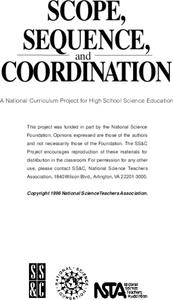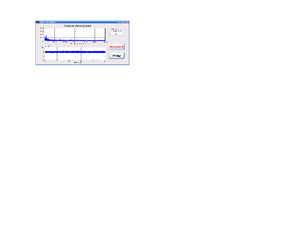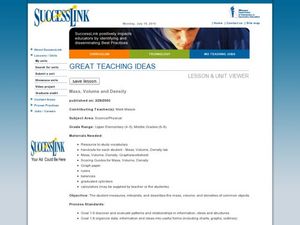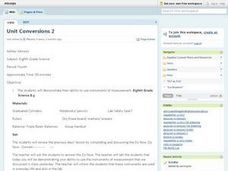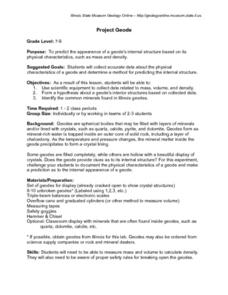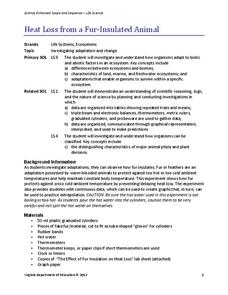Curated OER
The Triple Beam Balance
Students explore mass measurement. They complete a diagram of a triple beam balance. Students explore using the triple beam balance to determine the mass of an object. They discuss procedures for using the triple beam balance.
Curated OER
Matter and Energy
Does the change in energy of matter lead to a change in mass? Upcoming chemists compare the mass of equal-volume, but different-temperature liquids and materials both before and after a chemical reaction has occurred. In another...
Curated OER
Density Lab Activities
Young scholars participate in several density lab activities in order to clarify the misconceptions that solids sink and liquids float. Students work with triple beam balances to find mass of objects to calculate density.
Curated OER
Measuring Yourself Using the Metric System
Students measure using the metric system. In this geometry instructional activity, students solve problems using grams, meters and liters. They convert between the US units of measurements and the Metric System.
Curated OER
Using Density to Identify Wood Types
Students identify different woods based on their density. In this density lesson plan, students use a triple beam balance to find the mass and a metric ruler for the volume. They look through various wood blocks and identify what type of...
Curated OER
The Inertial Balance
Students weigh objects using a triple beam balance. In this mass lesson, students use an inertial balance made with a metal rod to measure and graph vibrations of varying numbers of pennies in a bucket. References and discussion prompts...
Virginia Department of Education
States and Forms of Energy
Energy is just energy, right? Explain various forms of energy to your young scientists by using an interactive experiment that contains common objects to demonstrate complex concepts. Pupils conduct experiments for radiant, thermal,...
Florida International University
Are You Concentrating?
Explore the importance of a concentration gradient in the rates of dissolution. Using the ocean ecosystem, learners study rates of dissolution around coral reefs. A hands-on experiment helps individuals discover the effects of changing a...
LABScI
Cell Diffusion and Permeability: The See-Thru Egg Lab
Create a model to study a microscopic phenomenon. The seventh of 12 lessons uses an egg (without its shell) to represent a cell membrane. Using different solutions, learners explore the concept of cell diffusion. They monitor...
Curated OER
Mass, Volume and Density
Students compare and contrast the mass, volume, and density of various objects. They use a triple beam balance, measure and record the volume of a cup of water, and discuss the results.
Curated OER
Unit Conversions 2
Eighth graders demonstrate the use of instruments of measurement. As a class, they take notes and observe the proper procedure for using a graduated cylinder, a ruler, and a balance/triple beam balance. In groups, 8th graders visit...
Curated OER
Practice with Mass
Fourth graders investigate the weight/mass of a number of items using grams, and equivalents. They examine the use of a triple beam balance before massing objects including oil and water. They go over the weights they amassed and weigh...
Curated OER
Law of Conservation of Mass
Students work in small groups. They grab a handful of ice, and place the ice in an empty beaker of ice using a triple beam balance. Students heat up the beaker of ice over a hot plat until the ice has changed into water. They measure...
Virginia Department of Education
Heat and Thermal Energy Transfer
How does radiation affect our daily lives? Answer that question and others with a lesson that discusses radiation and its use in thermal energy transfer through electromagnetic waves. Pupils investigate vaporization and...
Santa Monica College
Introducing Measurements in the Laboratory
We use basic units of measurement to break down things and communicate clearly. The first lesson in an 11-part series teaches the proper way to measure various items. It starts simply with measuring the dimensions and areas of geometric...
Curated OER
Project Geode
Young geologists attempt to predict the appearnace of a geode's internal structure based on how it looks from the outside, its mass, and its physical characteristics. In this geologly lesson, learners use scientific equipment to collect...
Curated OER
Balance and Gravity
Students examine the concepts of balance. In this balance and gravity lesson students view a demonstration of a leaning tower and see how to find the center of gravity.
Cornell University
Density
Certain things just do not mix, including liquids of varying densities. Learners collect data to determine the densities of several liquids. They then use the density information to predict the type of liquid.
Curated OER
Balancing Bottles
Students explore the Law of Conservation of Matter using effervescent tablets. In this mass and energy lesson, students investigate how mass is conserved in the reaction of effervescent tablets and water. They will discuss and...
Virginia Department of Education
The Law of Conservation of Matter
The Law of Conservation of Matter can be complex for young scientists to fully grasp. Use this experiment to help simplify the process as pupils perform two experiments to determine mass: one that melts a substance and the other that...
Virginia Department of Education
Heat Loss from a Fur-Insulated Animal
How do animals adapt to weather changes? Provide your class with the ability to understand adaptations and body temperature as they participate in this hands on experiment, using fake fur and hot water. Pupils collect data and...
Curated OER
Vector Lab
Here is a math lab that helps young mathematicians understand the real-life meaning for vector addition. By building a model using spring scales and washers as weight, and then calculating the vector addition using two different methods,...
Curated OER
To Float or Not to Float - A Lesson on Density
Learners observe and experiment with the concept of density. This is done using a simple experiment that helps them to apply scientific principles of observation and proving a hypothesis.
Curated OER
The Metric System
Learners practice converting metric measurements by completing the activities listed in this instructional activity. They first practice measuring common objects. They then convert metric measurements using the included worksheet.

